Shihang Lu
Constellation Shaping for OFDM-ISAC Systems: From Theoretical Bounds to Practical Implementation
Sep 04, 2025Abstract:Integrated sensing and communications (ISAC) promises new use cases for mobile communication systems by reusing the communication signal for radar-like sensing. However, sensing and communications (S&C) impose conflicting requirements on the modulation format, resulting in a tradeoff between their corresponding performance. This paper investigates constellation shaping as a means to simultaneously improve S&C performance in orthogonal frequency division multiplexing (OFDM)-based ISAC systems. We begin by deriving how the transmit symbols affect detection performance and derive theoretical lower and upper bounds on the maximum achievable information rate under a given sensing constraint. Using an autoencoder-based optimization, we investigate geometric, probabilistic, and joint constellation shaping, where joint shaping combines both approaches, employing both optimal maximum a-posteriori decoding and practical bit-metric decoding. Our results show that constellation shaping enables a flexible trade-off between S&C, can approach the derived upper bound, and significantly outperforms conventional modulation formats. Motivated by its practical implementation feasibility, we review probabilistic amplitude shaping (PAS) and propose a generalization tailored to ISAC. For this generalization, we propose a low-complexity log-likelihood ratio computation with negligible rate loss. We demonstrate that combining conventional and generalized PAS enables a flexible and low-complexity tradeoff between S&C, closely approaching the performance of joint constellation shaping.
Sensing With Random Communication Signals
Apr 09, 2025



Abstract:Communication-centric Integrated Sensing and Communication (ISAC) has been recognized as a promising methodology to implement wireless sensing functionality over existing network architectures, due to its cost-effectiveness and backward compatibility to legacy cellular systems. However, the inherent randomness of the communication signal may incur huge fluctuations in sensing capabilities, leading to unfavorable detection and estimation performance. To address this issue, we elaborate on random ISAC signal processing methods in this article, aiming at improving the sensing performance without unduly deteriorating the communication functionality. Specifically, we commence by discussing the fundamentals of sensing with random communication signals, including the performance metrics and optimal ranging waveforms. Building on these concepts, we then present a general framework for random ISAC signal transmission, followed by an in-depth exploration of time-domain pulse shaping, frequency-domain constellation shaping, and spatial-domain precoding methods. We provide a comprehensive overview of each of these topics, including models, results, and design guidelines. Finally, we conclude this article by identifying several promising research directions for random ISAC signal transmission.
Joint Optimization of Geometric and Probabilistic Constellation Shaping for OFDM-ISAC Systems
Jan 20, 2025
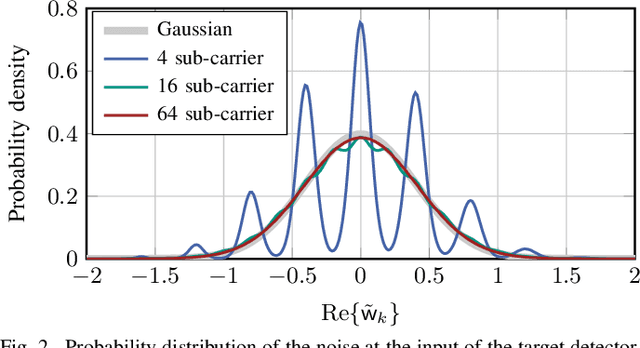

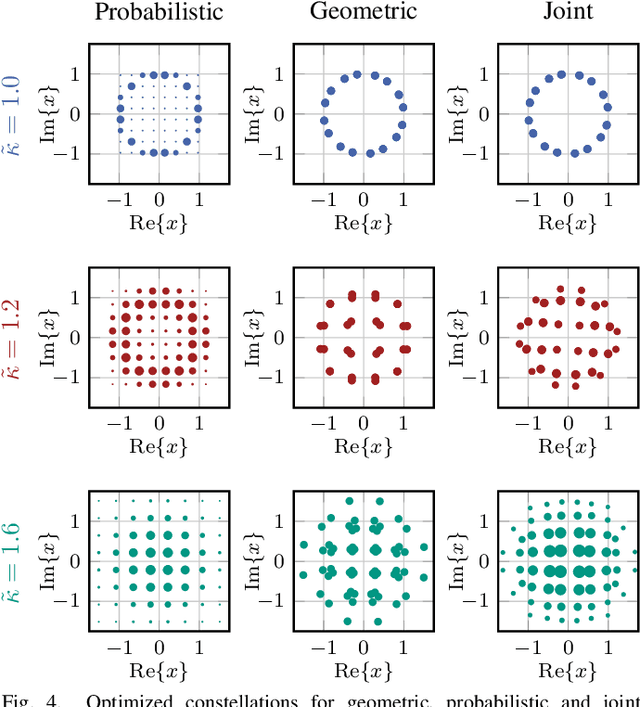
Abstract:6G communications systems are expected to integrate radar-like sensing capabilities enabling novel use cases. However, integrated sensing and communications (ISAC) introduces a trade-off between communications and sensing performance because the optimal constellations for each task differ. In this paper, we compare geometric, probabilistic and joint constellation shaping for orthogonal frequency division multiplexing (OFDM)-ISAC systems using an autoencoder (AE) framework. We first derive the constellation-dependent detection probability and propose a novel loss function to include the sensing performance in the AE framework. Our simulation results demonstrate that constellation shaping enables a dynamic trade-off between communications and sensing. Depending on whether sensing or communications performance is prioritized, geometric or probabilistic constellation shaping is preferred. Joint constellation shaping combines the advantages of geometric and probabilistic shaping, significantly outperforming legacy modulation formats.
Uncovering the Iceberg in the Sea: Fundamentals of Pulse Shaping and Modulation Design for Random ISAC Signals
Jan 03, 2025



Abstract:Integrated Sensing and Communications (ISAC) is expected to play a pivotal role in future 6G networks. To maximize time-frequency resource utilization, 6G ISAC systems must exploit data payload signals, that are inherently random, for both communication and sensing tasks. This paper provides a comprehensive analysis of the sensing performance of such communication-centric ISAC signals, with a focus on modulation and pulse shaping design to reshape the statistical properties of their auto-correlation functions (ACFs), thereby improving the target ranging performance. We derive a closed-form expression for the expectation of the squared ACF of random ISAC signals, considering arbitrary modulation bases and constellation mappings within the Nyquist pulse shaping framework. The structure is metaphorically described as an ``iceberg hidden in the sea", where the ``iceberg'' represents the squared mean of the ACF of random ISAC signals, that is determined by the pulse shaping filter, and the ``sea level'' characterizes the corresponding variance, caused by the randomness of the data payload. Our analysis shows that, for QAM/PSK constellations with Nyquist pulse shaping, Orthogonal Frequency Division Multiplexing (OFDM) achieves the lowest ranging sidelobe level across all lags. Building on these insights, we propose a novel Nyquist pulse shaping design to enhance the sensing performance of random ISAC signals. Numerical results validate our theoretical findings, showing that the proposed pulse shaping significantly reduces ranging sidelobes compared to conventional root-raised cosine (RRC) pulse shaping, thereby improving the ranging performance.
Communication-Assisted Sensing in 6G Networks
Nov 13, 2023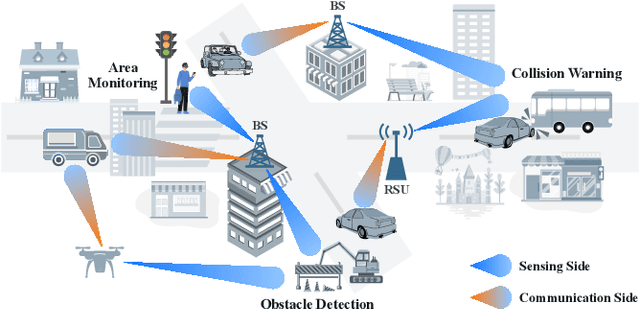
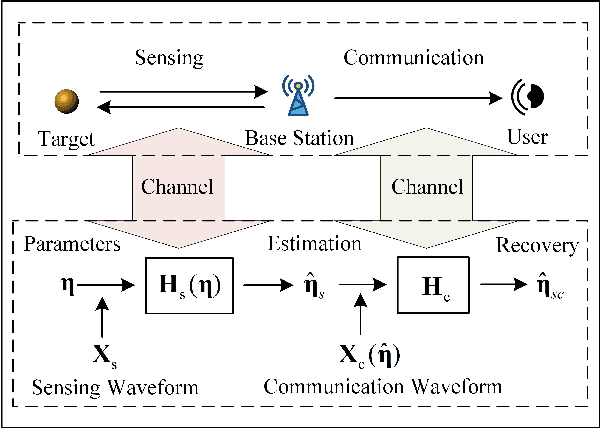
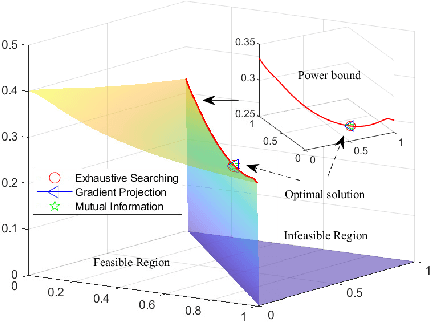
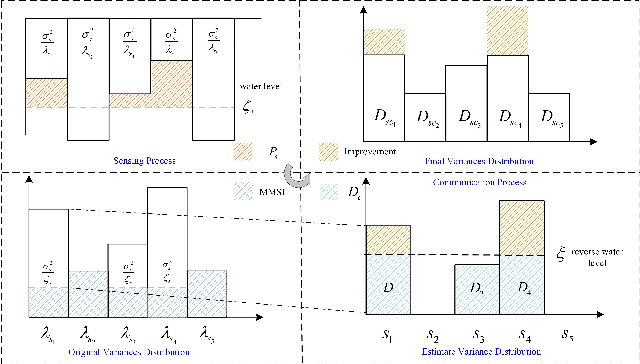
Abstract:The exploration of coordination gain achieved through the synergy of sensing and communication (S&C) functions plays a vital role in improving the performance of integrated sensing and communication systems. This paper focuses on the optimal waveform design for communication-assisted sensing (CAS) systems within the context of 6G perceptive networks. In the CAS process, the base station actively senses the targets through device-free wireless sensing and simultaneously transmits the pertinent information to end-users. In our research, we establish a CAS framework grounded in the principles of rate-distortion theory and the source-channel separation theorem (SCT) in lossy data transmission. This framework provides a comprehensive understanding of the interplay between distortion, coding rate, and channel capacity. The purpose of waveform design is to minimize the sensing distortion at the user end while adhering to the SCT and power budget constraints. In the context of target response matrix estimation, we propose two distinct waveform strategies: the separated S&C and dual-functional waveform schemes. In the former strategy, we develop a simple one-dimensional search algorithm, shedding light on a notable power allocation tradeoff between the S&C waveform. In the latter scheme, we conceive a heuristic mutual information optimization algorithm for the general case, alongside a modified gradient projection algorithm tailored for the scenarios with independent sensing sub-channels. Additionally, we identify the presence of both subspace tradeoff and water-filling tradeoff. Finally, we validate the effectiveness of the proposed algorithms through numerical simulations.
Random ISAC Signals Deserve Dedicated Precoding
Nov 03, 2023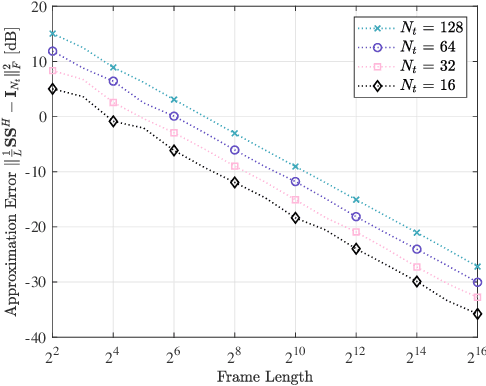
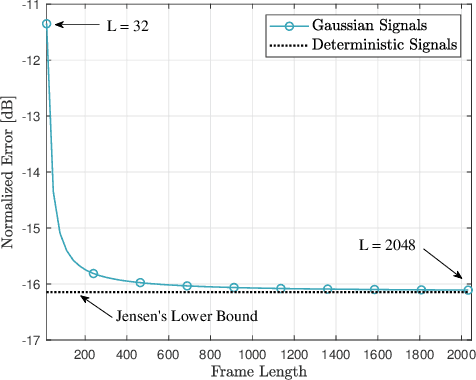
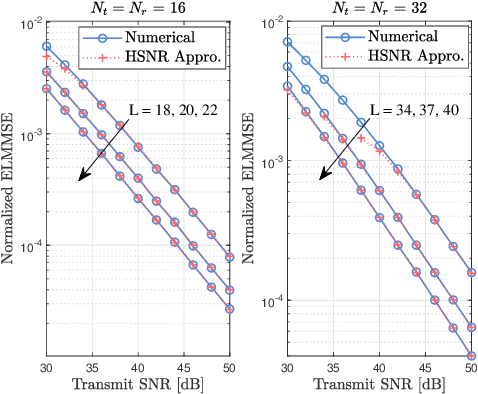
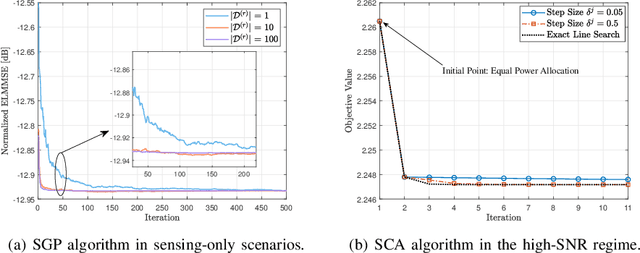
Abstract:Radar systems typically employ well-designed deterministic signals for target sensing, while integrated sensing and communications (ISAC) systems have to adopt random signals to convey useful information. This paper analyzes the sensing and ISAC performance relying on random signaling in a multiantenna system. Towards this end, we define a new sensing performance metric, namely, ergodic linear minimum mean square error (ELMMSE), which characterizes the estimation error averaged over random ISAC signals. Then, we investigate a data-dependent precoding (DDP) scheme to minimize the ELMMSE in sensing-only scenarios, which attains the optimized performance at the cost of high implementation overhead. To reduce the cost, we present an alternative data-independent precoding (DIP) scheme by stochastic gradient projection (SGP). Moreover, we shed light on the optimal structures of both sensing-only DDP and DIP precoders. As a further step, we extend the proposed DDP and DIP approaches to ISAC scenarios, which are solved via a tailored penalty-based alternating optimization algorithm. Our numerical results demonstrate that the proposed DDP and DIP methods achieve substantial performance gains over conventional ISAC signaling schemes that treat the signal sample covariance matrix as deterministic, which proves that random ISAC signals deserve dedicated precoding designs.
Sensing With Random Signals
Sep 06, 2023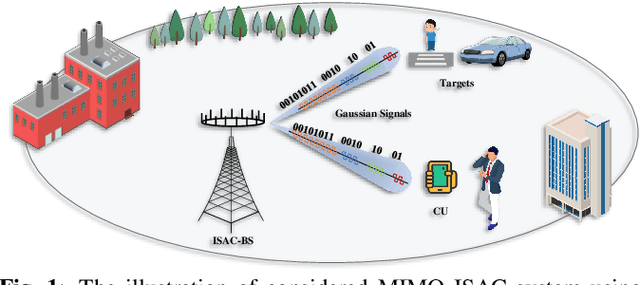

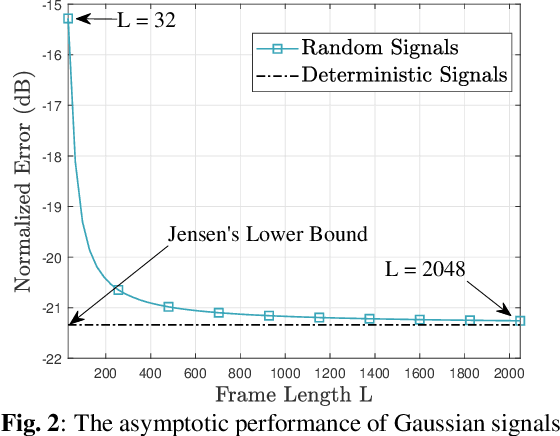
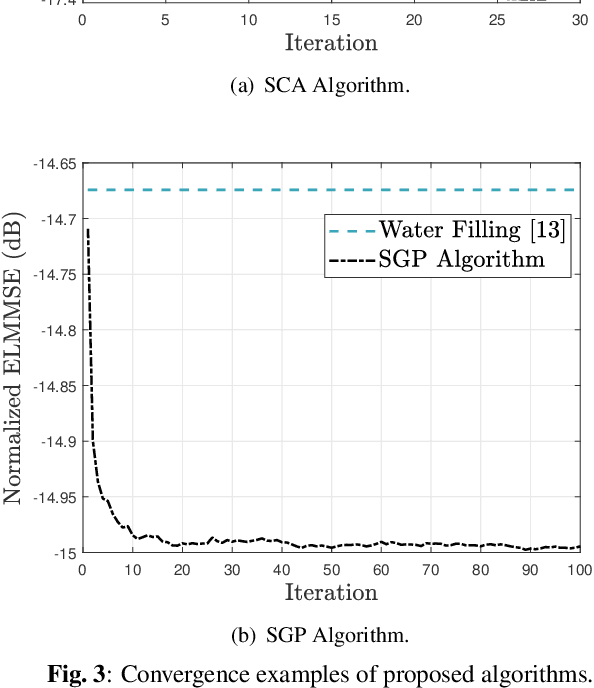
Abstract:Radar systems typically employ well-designed deterministic signals for target sensing. In contrast to that, integrated sensing and communications (ISAC) systems have to use random signals to convey useful information, potentially causing sensing performance degradation. This paper analyzes the sensing performance via random ISAC signals over a multi-antenna system. Towards this end, we define a new sensing performance metric, namely, ergodic linear minimum mean square error (ELMMSE), which characterizes the estimation error averaged over the randomness of ISAC signals. Then, we investigate a data-dependent precoding scheme to minimize the ELMMSE, which attains the {optimized} sensing performance at the price of high computational complexity. To reduce the complexity, we present an alternative data-independent precoding scheme and propose a stochastic gradient projection (SGP) algorithm for ELMMSE minimization, which can be trained offline by locally generated signal samples. Finally, we demonstrate the superiority of the proposed methods by simulations.
Sensing as a Service in 6G Perceptive Mobile Networks: Architecture, Advances, and the Road Ahead
Aug 16, 2023Abstract:Sensing-as-a-service is anticipated to be the core feature of 6G perceptive mobile networks (PMN), where high-precision real-time sensing will become an inherent capability rather than being an auxiliary function as before. With the proliferation of wireless connected devices, resource allocation in terms of the users' specific quality-of-service (QoS) requirements plays a pivotal role to enhance the interference management ability and resource utilization efficiency. In this article, we comprehensively introduce the concept of sensing service in PMN, including the types of tasks, the distinctions/advantages compared to conventional networks, and the definitions of sensing QoS. Subsequently, we provide a unified RA framework in sensing-centric PMN and elaborate on the unique challenges. Furthermore, we present a typical case study named "communication-assisted sensing" and evaluate the performance trade-off between sensing and communication procedure. Finally, we shed light on several open problems and opportunities deserving further investigation in the future.
Waveform Design for Communication-Assisted Sensing in 6G Perceptive Networks
May 19, 2023Abstract:The integrated sensing and communication (ISAC) technique has the potential to achieve coordination gain by exploiting the mutual assistance between sensing and communication (S&C) functions. While the sensing-assisted communications (SAC) technology has been extensively studied for high-mobility scenarios, the communication-assisted sensing (CAS) counterpart remains widely unexplored. This paper presents a waveform design framework for CAS in 6G perceptive networks, aiming to attain an optimal sensing quality of service (QoS) at the user after the target's parameters successively ``pass-through'' the S$\&$C channels. In particular, a pair of transmission schemes, namely, separated S&C and dual-functional waveform designs, are proposed to optimize the sensing QoS under the constraints of the rate-distortion and power budget. The first scheme reveals a power allocation trade-off, while the latter presents a water-filling trade-off. Numerical results demonstrate the effectiveness of the proposed algorithms, where the dual-functional scheme exhibits approximately 12% performance gain compared to its separated waveform design counterpart.
Integrated Sensing and Communications: Recent Advances and Ten Open Challenges
Apr 29, 2023
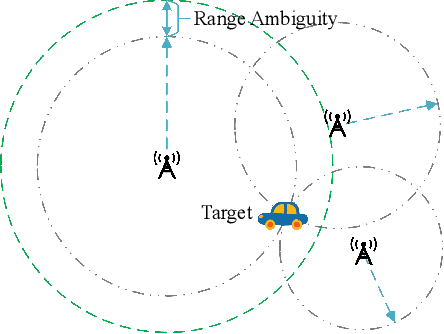
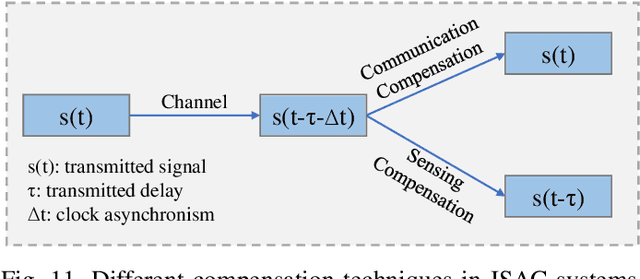
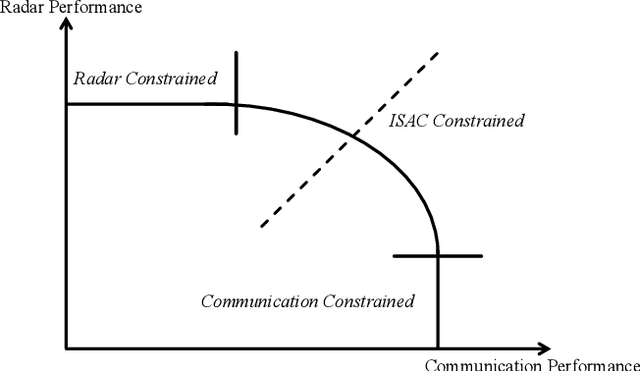
Abstract:It is anticipated that integrated sensing and communications (ISAC) would be one of the key enablers of next-generation wireless networks (such as beyond 5G (B5G) and 6G) for supporting a variety of emerging applications. In this paper, we provide a comprehensive review of the recent advances in ISAC systems, with a particular focus on their foundations, system design, networking aspects and ISAC applications. Furthermore, we discuss the corresponding open questions of the above that emerged in each issue. Hence, we commence with the information theory of sensing and communications (S$\&$C), followed by the information-theoretic limits of ISAC systems by shedding light on the fundamental performance metrics. Next, we discuss their clock synchronization and phase offset problems, the associated Pareto-optimal signaling strategies, as well as the associated super-resolution ISAC system design. Moreover, we envision that ISAC ushers in a paradigm shift for the future cellular networks relying on network sensing, transforming the classic cellular architecture, cross-layer resource management methods, and transmission protocols. In ISAC applications, we further highlight the security and privacy issues of wireless sensing. Finally, we close by studying the recent advances in a representative ISAC use case, namely the multi-object multi-task (MOMT) recognition problem using wireless signals.
 Add to Chrome
Add to Chrome Add to Firefox
Add to Firefox Add to Edge
Add to Edge